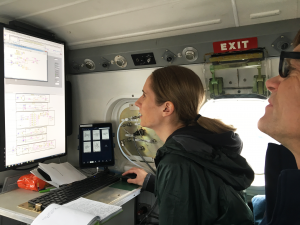22 July 2019
WASHINGTON — Atmospheric methane is a powerful greenhouse gas that also contributes to ground-level ozone pollution. In the past decade, there has been intense scientific focus on improving the accuracy of methane emissions estimates in the United States, with most of the effort targeting oil- and natural gas-producing basins.
Now, a new study in the AGU journal Geophysical Research Letters using an instrumented airplane has found unexpectedly large emissions over five major cities along the East Coast – twice the total amount of methane and almost 10 times the amount estimated from natural gas.
The analysis was based on airborne measurements taken from NOAA Twin Otter aircraft along the East Coast of the United States during the course of 20 research flights between April 8, 2018 to May 12, 2018, totaling 120 flight hours. The flights covered Washington, Baltimore, Philadelphia, New York, Providence and Boston, with instruments measuring levels of methane, carbon dioxide, carbon monoxide, and ethane upwind and downwind of urban areas. Methane is a primary component of natural gas.
“The amount of natural gas that flows into these older cities is very large,” said lead author Genevieve Plant, of the University of Michigan. “That means leakage from old cast-iron pipes and “end-use” losses from inefficient appliances could be potentially be significant. We found methane emissions in the five largest cities that we sampled are significant – about double what the EPA estimates for the total emissions.”
Climate and air-quality impacts

A NOAA Twin Otter aircraft over the Hudson on a 2018 research mission.
Credit: Eric Kort/University of Michigan.
Quantifying methane emissions is important for assessing its current and future impact on climate and air quality. Generally, there are two main sources of methane emissions from cities: methane created by the decay of organic material in landfills, and methane in releases of natural gas from old or leaky pipes, incomplete combustion from older appliances, etc.
Ethane is a component of natural gas, but is not generated by landfill, and utilities have precise measurements of how much ethane is in the gas they deliver. So it’s useful as a tracer for separating emissions coming from fossil fuel from those coming from landfills.
One recent synthesis study that estimated emissions from the production field all the way to the edge of cities found methane emissions were 60 percent higher than estimated by the EPA, said NOAA scientist Colm Sweeney. But that study, like most others, was not focused on examining the loss during distribution and end-use in homes and businesses.
The new study, by contrast, directly measured downwind plumes of emissions coming from these five cities, which included leaks from pipes and appliances. The methods used allowed scientists to quantify the total amount of methane coming from the city. Scientists analyzed the ratio of ethane to methane to calculate how much methane was due to natural gas leakage.
A lack of data

Genevieve Plant of the University of Michigan and NOAA’s Colm Sweeney review measurements of methane and other gases during an airborne research project in 2018.
Credit: Eric Kort/University of Michigan
There’s a real lack of data on urban emissions, including end-use losses,” Sweeney said. “In our study, we found leaks and end-use losses in just five cities was larger than what EPA estimates for leaks in the entire country. That was kind of stunning. The problem is we still do not exactly where it is coming from. Is it the pipes? Is it the appliances? What we do know is that this provides a huge opportunity for emissions reduction if we can determine the source of these leaks”
While there have been a handful of other studies of urban areas scattered around the country, this study sampled one of the largest metropolitan megaplexes, home to about 12 percent of the US population.
“It’s unclear how representative the cities we looked at are compared to other cities in the US,” Plant said. “Clearly, more work needs to be done.”
Plant said the research flights – typically at around 1,000 to 1,500 feet off the ground – made for an unusually scenic research environment. “It was quite the view,” she said. “We flew up the Hudson a few times. Flying off the coast is also quite picturesque, to say the least.”
###
Founded in 1919, AGU is a not-for-profit scientific society dedicated to advancing Earth and space science for the benefit of humanity. We support 60,000 members, who reside in 135 countries, as well as our broader community, through high-quality scholarly publications, dynamic meetings, our dedication to science policy and science communications, and our commitment to building a diverse and inclusive workforce, as well as many other innovative programs. AGU is home to the award-winning news publication Eos, the Thriving Earth Exchange, where scientists and community leaders work together to tackle local issues, and a headquarters building that represents Washington, D.C.’s first net zero energy commercial renovation. We are celebrating our Centennial in 2019. #AGU100
*****
Notes for Journalists
This paper is freely available for 30 days. Journalists and public information officers (PIOs) can download a PDF copy of the article by clicking on this link:
https://agupubs.onlinelibrary.wiley.com/doi/abs/10.1029/2019GL082635
Journalists and PIOs may also request a copy of the final paper by emailing Nanci Bompey at [email protected]. Please provide your name, the name of your publication, and your phone number.
Neither this paper nor this press release is under embargo.
“Large fugitive methane emissions from urban centers along the US East Coast”
Authors
G. Plant: Department of Climate and Space Sciences and Engineering, University of Michigan, Ann Arbor, MI, USA;
E.A. Kort: Department of Climate and Space Sciences and Engineering, University of Michigan, Ann Arbor, MI, USA;
C. Floerchinger: Earth and Planetary Sciences, Harvard University, Cambridge, MA, USA;
A. Gvakharia: Department of Climate and Space Sciences and Engineering, University of Michigan, Ann Arbor, MI, USA;
I. Vimont and C. Sweeney: Global Monitoring Division, Earth System Research Laboratory, National Oceanic and Atmospheric Administration, Boulder, CO, USA.
Contact information for the researchers:
Genevieve Plant, University of Michigan
[email protected]
Eric Kort, University of Michigan
+1 (734) 763-8414
[email protected]
Nanci Bompey
+1 (202) 777-7524
[email protected]
NOAA Press Contact:
Theo Stein
+1 (303) 497-6288
[email protected]
University of Michigan Press Contact:
Nicole Casal Moore
+1 (734) 647-7087
[email protected]